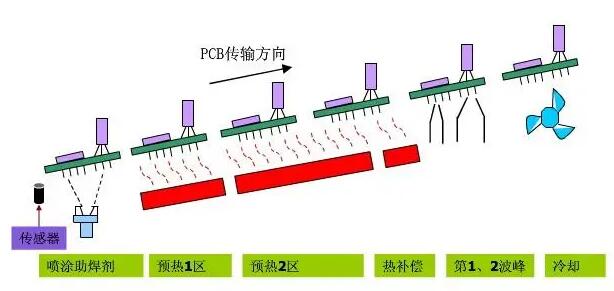1. Now the SMT reflow furnace of PCBA processing plant almost does not use [IR Reflow], and all have been changed to [Convection Reflow] hot air reflow furnace.
IR is the English abbreviation of Infrared (infrared). Many early reflow furnaces did use infrared to heat, but infrared heating has many shortcomings. The biggest problem is uneven heating, because infrared is very affected by the color of the parts. Obviously, parts with darker colors are heated faster, and parts with lighter colors are heated more slowly.
In addition, small parts hiding next to large parts will be blocked, not easily exposed to infrared rays, and there will be another shadow effect problem of insufficient heating. All these, the current PCBA processing plants should not see any [IR Reflow]. So when you want to talk about the reflow furnace, don’t call it [IR Reflow] anymore. As long as the English of the reflow furnace is [Reflow], everyone can understand it. If you insist on expressing your knowledge, you can call it [Convection Reflow], "Convection Reflow Furnace" or [Hot Air Reflow], "Hot Air Reflow Furnace".

2. Reflow Chinese should be translated into [Reflow] or [Reflow] instead of .
Reflow is a "solder paste" made by mixing alloyed tin powder and flux. Through a heating process, it is restored to the original solder joints and the original solder, instead of having a "go" next to the word If it is said that it is called "fluid", it will mean turning around repeatedly.
Suggested further reading: What is SMT (Surface Mount Technology)?
3. The Chinese of SMT (Surface Mount Technology) should be translated into [Surface Mount Technology], not [adhesive].
Because the electronic parts are attached to the circuit board and re-soldered to the circuit board after the Reflow operation, the solder paste is not [glue], it is not glued to the PCB circuit board.
4. Soak Zone Chinese should be translated into [heat-absorbing area], not "soaking area".
The purpose of the second paragraph of "SMT Reflow Profile" [Soak zone] is to allow all the parts that need to be welded together to absorb enough heat (thermal mass), so that components of different textures and sizes can maintain a consistent uniform temperature. When the board surface temperature difference △T is close to the minimum value, it can continue to the next reflow zone stage, and at the same time melt the tin and achieve the purpose of welding.
5. The advantages of adding [Nitrogen (N2)] to the reflow furnace
Because nitrogen (N2) is a kind of inert gas, it is not easy to produce compounds with metals, and it can also avoid the oxidation reaction of oxygen in the air with metals. The advantages of adding nitrogen to the reflow furnace are as follows:
▪ The surface tension of the solder paste can be reduced, which is conducive to solder climbing.
▪ It can reduce oxidation, so that the second side of the PCB is not easily oxidized when the first side is passed through the furnace, which is conducive to secondary reflow, can produce better soldering, and can also reduce the generation of voids.
▪ Reduce the void rate (void). Because the oxidation of the solder paste or solder pad is reduced, voids are naturally reduced.
In addition, there is also research and development to add nitrogen to the wave soldering furnace. The advantage is that it can reduce the oxidation speed of the liquid tin bath, because long-term contact with liquid tin and air will form tin slag, and some finer tin slag will follow The flooding tin is attached to the surface of the PCB. If it is just connected between two tin points, it will form a short circuit. Another advantage is that it can increase the tin-eating rate of pin parts, because the surface tension of tin becomes smaller, which is conducive to tin climbing. However, nitrogen is not cheap, and the consumption of nitrogen for wave soldering is greater than for soldering.
6. Wave soldering in Chinese should be translated into [Wave Soldering] instead of [Wave Soldering].
PCBA wave soldering process
[Wave soldering] is the use of tin waves to solder the pin parts to the circuit board. Although most [Wave soldering] machines have two tin waves, the first is a spoiler wave like a fountain, which is used to strengthen welding and eliminate the shadow effect of large parts; the second is a flat wave like a mirror. Used to scrape more than
Strictly speaking, the soldering place is not the wave "peak", at least the second plane wave has no wave peak, and the English wave peak should be called [Crest] instead of [Wave], so [Wave soldering] just needs to be translated into [Wave soldering] That's it, there is no [peak].
7. It is not recommended to use solder bars or bars with SAC components in the lead-free solder pool of the wave soldering furnace
SAC is the abbreviation of tin (Sn) silver (Ag) copper (Cu), and the most commonly used is SAC305, which means that it contains 96.5% tin (Sn), 3.0% silver (Ag) and 0.5% copper (Cu) However, if the copper content of the wave soldering pool is too high, it will easily cause the problem of short circuit of the pin soldering parts; secondly, it will cause the problem of "copper biting" on the surface of the circuit board over the wave soldering surface.
Note: This should be for OSP boards, ENIG boards should be less problematic.
8. Automotive assembly circuit boards require leaded socket soldering
This is because the soldering strength of lead soldering (Sn63/Pd37) is much higher than that of lead-free soldering (SAC305), and the soldering strength of through hole soldering (Through Hole) is also higher than that of SMT patch soldering.